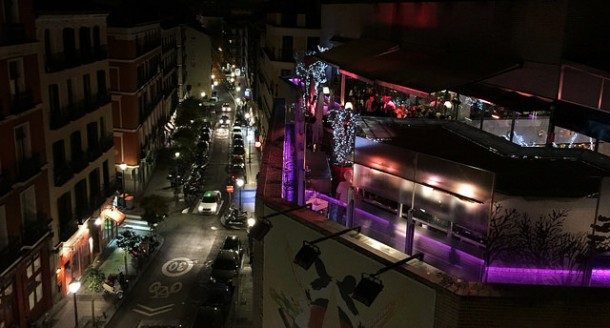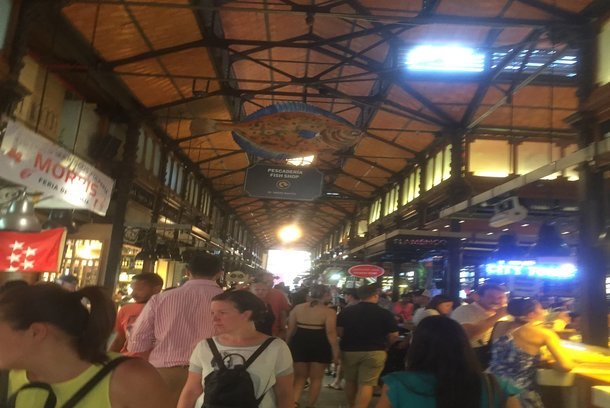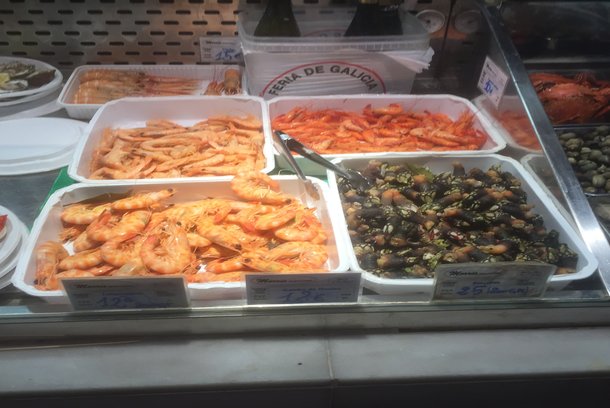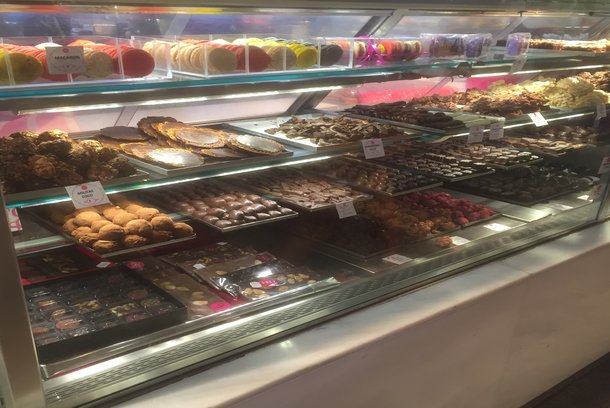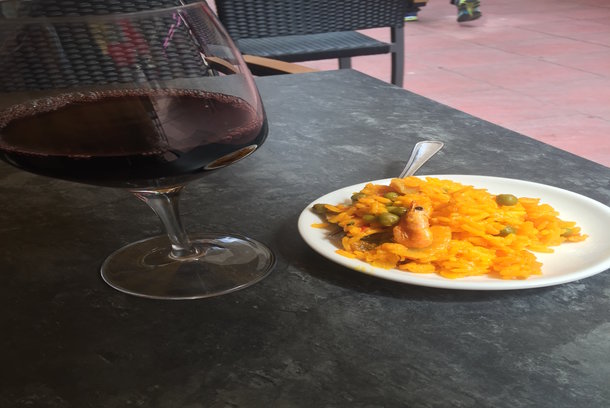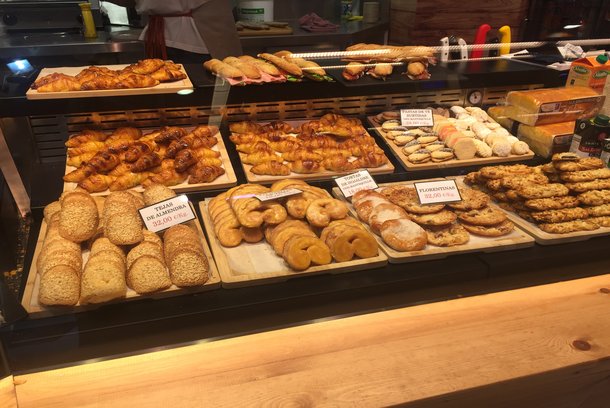In Chueca, a trendy neighbourhood in the centre of Madrid, a restaurant called Gastromaquia is hidden off a side street. Inside, behind the blue walls, a tapas revolution is brewing: traditional dishes moulded into something modern yet unpretentious and delicious.
Fresh mussels flavoured with tikka masala. Creamy guacamole peppered with fresh tomato and served with crisp banana chips for dipping. Grilled goats cheese covered in honey and basil. The food is simple, and complex, and represents the forward thinking cuisine in the city which is often compared unfavourably to Barcelona, the capital’s rival in many things, mostly football.
The culinary scene in Madrid is rapidly changing. High numbers of immigration, and a melting pot of different cultures, has resulted in a mix of gastronomy throughout the city and its different neighbourhoods. A Spanish friend shared some knowledge: To really discover the heart of Madrid food, you need to uncover the markets.
I noted three things on my list that I knew that Madrid, and Spain as a whole obviously, was famous for: tapas, seafood and churros. However, it would be madness to limit the fine cuisine of this city to the traditional dishes and stereotyped paella and sangria. I was open to anything, and ready to embrace the host of diverse and modern food bursting throughout the cityscape.
Here, I compiled the top three food markets in Madrid. Check them out.
1. Mercado de San Anton
Vibe: Young, trendy
Average Cost: €10
Chueca, an until recently rundown area in the centre of Madrid, has the gay community to thank for its revitalisation and modernisation. Rainbow flags hang proud from balconies, and the multi-coloured message of love, is splattered inside the metro walls. Now, the barrio buzzes with sophisticated food and drink. This modern food scene in Chueca extends to the nearby Mercado de San Anton, a three-storey high, food lovers jungle gym. Downstairs, the market is filled with fresh produce and local ingredients. The stalls maintain a traditional Spanish feel and attract locals as well as tourists. The 22 vendors on this level sell everything from typical Spanish meats to creamy foie-gras risotto packed with mushrooms. Over 60 types of breads can be purchased from as little as €1. Upstairs, take-away stalls and show-cooking areas allow customers to watch their food be prepared. You can scurry up onto this level, arms full of wonderful ingredients just purchased, and relax as chefs turn them into dishes. Here, you can visit the wine cellar and taste an array of Spanish wines. However, the market’s unique selling point is the roof terrace. Views extend for miles across Madrid. Young professionals laugh and sip Gin and Tonics in the restaurant and bar area. The far reaching cuisine ranges from Japan to the Canary Islands and beyond to more traditional dishes.
2. Mercado de San Miguel
Vibe: Lively, touristy,
Average Cost: €15
Some Spanish friends and other foodie enthusiasts suggested to start at the Mercado de San Miguel, a gridlock bursting with stalls, bars and cafes near the Plaza Mayor in the centre of the city. The market, a glass and iron masterpiece from the early 20th century, reopened in 2009 after a six year restoration period and soon marked itself as a tourist hotspot with every type of cuisine you can imagine: sushi, oysters, pizza and traditional tapas to name a few.
San Miguel leans towards the higher priced end of markets and focuses more on restaurant dishes than selling produce and ingredients, with the exception of the readily available fresh fish. Prawns, langoustines, mussels, oysters and cod lie in full colour on beds of ice. This market is filled with tourists, much more than in any of the other markets on this list. I visited San Miguel on my eighth day in Madrid, and it was the first time I felt myself drowning in the English language.
Situated on a bar stool, enjoying a glass of sangria, and the surrounding three tables feature city guides and Real Madrid souvenirs. If you prefer a more authentic Spanish atmosphere and traditional dishes, then perhaps avoid this market. For those who do not mind the commercial, international feel then head to Beer House for some cerveza and then fuel up at the croquetas cart. A mozzarella and burrata stand specialises in all varieties of the creamy cheese teamed up unique combinations for as little as €3.00. The chocolatier stand boasts sweet, chewy macaroons and crunchy, salty clusters of biscuit smothered in layers of dark chocolate starting at around €1.00.
3. Mercado de la Paz
Vibe: Relaxed, local
Average Cost: Under €10
The Mercado de la Paz, 130 years old, and situated in the upscale Salamanca neighbourhood of the city epitomises typical Spanish markets. Nestled amongst designer boutiques and interior design shops, sits this quaint little collection of stalls busting with local produce. Here, you are more likely to eat with locals rather than excitable tourists showcasing sunburn and polyester bumbags.
On a lazy Monday lunchtime, the older ladies bustle through the stalls with push trolleys and crumbled paper shopping lists detailing ingredients and essentials for the upcoming week. Spanish businessmen line the surrounding bars with newspapers in hand and coffees cooling on the scattered metal tables. The stalls themselves are lined with pescado, jamon y queso. Delicious empanadas stuffed with chorizo, spicy meat and fried onions cost as little as €1. You see bronzed women devouring artisan sandwiches, toasted sourdough lined with fresh garlic prawns and smothers of real alioli. Their hands are full of shopping bags and their feet clad in soft Spanish leather. The place is serene, relaxed.
La Niña tapas bar is the perfect place to people watch as they saunter under the red entrance. Situated just within the walls of the market, here you can enjoy tapas from as little as €2. A glass of Rioja, itself only €2.50, is served with a smile along with a ladleful of seafood paella resting on a china saucer. Little prawns and tiny clams hide amongst the fluffy, golden rice. The bravas mixtas is what you would expect: pillowy clouds of soft potato with a crunchy skin, drowning in more garlic alioli and sweet and spicy tomato sauce for €4. It is a great alternative to the chaotic clamour in other city centre destinations.
What do you think? What are your favourite food markets in Madrid? Let us know in the comments below! If you are interested in finding out more about cuisine in the city, then check out this article on tapas here.



